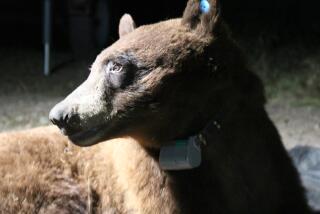Care Bears
- Share via
AGOURA HILLS — Marlene Thomas is a hunter.
She hunts for bears. The kind that come 12 inches high and 6 inches wide. She looks for them not in the woods but at charity organizations and fund-raisers. And her weapon of choice is not a shotgun or a steel trap, but a cordless phone with redial.
Animal lovers need not fear. The objects of Thomas’ desire are not living but made of brushed cotton, buttons and stuffing.
As head of the Southern California chapter of the Good Bears for the World, Thomas has found that cuddly, soft teddy bears can soothe the nerves of abused children, traumatized disaster victims and teenage runaways. The Agoura-based club, which stocks bears donated from toy companies in addition to bears they buy, is the only chapter in Southern California.
The group was formed in 1969 by James Owenby, a radio station owner from Hawaii, and now there are 57 “dens” all over the world. Owenby was influenced by “The Teddy Bear Book,” written by Col. Bob Henderson and Peter Bull. The book explains that teddy bears, like living dogs, cats and fish, have a positive emotional effect on people.
“Bears just have a magical way of calming people down,” said Thomas, head of the local club.
Gail Pincus, executive director of the Domestic Abuse Center in Northridge, agrees.
“They are so responsive,” she said of the club. “When we call and say we are running low on bears, they are here the next day with a boxful,” she said.
Pincus works with victims of domestic violence and calls Thomas every few weeks for her bear fix.
“The group is invaluable,” she said. “Whenever we go out on a call we always take a teddy bear along. It provides a Band-Aid to the troubles we run into.”
A small white bear is always packed alongside food vouchers, clothing certificates and emergency phone numbers in a kit given to victims.
“Once we were called to a home where the mother had just been beaten to a pulp in front of her two children. The boys were 11 and 9, a little too old maybe for a teddy bear, but they took the bears anyway,” Pincus said.
The boys had to describe and draw their version of the beating for police. The mother did not want her children to hear how her husband beat her and so asked to be interviewed at the police station away from the children. Pincus said reliving the violent episode is a draining experience for children who later cannot immediately turn to their mother for comfort.
“It’s odd to say, but the bears really do seem magical. By the time we left, both boys were clutching the bears while they sat on the couch watching television,” she said.
Thomas became involved after attending a toy fair where she met the group’s previous president. The two struck up a conversation, which gradually turned to the subject of Good Bears.
Thomas joined the group and has been involved ever since. She developed an interest in teddy bears herself after seeing a teddy bear collector’s magazine. Thomas said she enjoys in particular seeing children react to the bears in a positive way.
When the past president moved away, Thomas got the post. The bear supply is kept in her home and sometimes builds as high as 20 dozen, especially after the winter holidays.
*
An avid collector, Thomas, 58, has 200 in her personal menagerie ranging from the common $20 plush toy bear to a $2,000 Steiff antique that dates to 1907 and was appraised by Christie’s auction house.
Thomas said her tastes are simple.
“If I see a bear that I like, I’ll just get it,” she said.
The group gave away 1,600 stuffed bears last year, the majority to fire and police departments but also to agencies such as the Red Cross, victims of the Oklahoma City bombing and families of passengers on TWA Flight 800.
“We sent 100 right after the crash,” Thomas said.
The group’s national president suggested giving the bears to the families of TWA passengers after seeing news reports of people having trouble getting information from the airline.
“At first the airline company was polite but not really sure what to do with the bears. After they gave out the first batch they asked for 400 more,” she said.
The airline later sent gold wings to attendees of a Good Bears conference in Chicago, as a sign of appreciation.
Even families facing terminal illness use the bears to work through complex emotions.
“The bears are such a good tool,” said Jean Heister, a volunteer coordinator for the Hospice of Conejo, a nonprofit in Thousand Oaks. “They let people focus on something else while they work through their emotions. The bear just makes you feel safe, like a warm blanket.”
More to Read
Sign up for Essential California
The most important California stories and recommendations in your inbox every morning.
You may occasionally receive promotional content from the Los Angeles Times.













